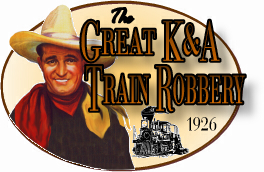

Fox Pictures
CAST: Tom Mix (Tom Gordon), Dorothy Dwan (Madge Cullen), William Walling (Eugene Cullen), Harry Grippe (Deluxe Harry), Carl Miller (Burton Holt), Edward Peil, Sr. (Bill Tolfree), Curtis McHenry (Cullen's Butler), Tony (Himself)
Tom Gordon is a special agent who is working undercover
to stop a gang of railroad bandits. He rescues Madge Cullen, the
daughter of the president of the railroad, when the bandits attempt
to kidnap her. However, she and her father think Tom is a bandit
(he's wearing a mask since he's undercover) and think the bandits
are a sheriff's posse chasing Tom. Because of this encounter,
Tom has fallen in love with Madge, and, although she won't admit
it, she likes him, too. Also, Tom has learned that Eugene Cullen's
secretary, Burton Holt, is an informant for the gang. Following
this escapade, Tom saves a hobo when his hammock breaks underneath
the train, and, as it turns out, they were 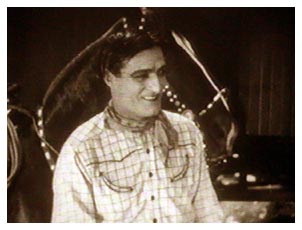 in
the army together during the war. Tom enlists Harry the hobo's
help to catch the crooks. He goes that night to Cullen's house
hoping to see Madge. However, he is discovered and must escape
from Cullen's men. He hides in Madge's room, and she doesn't give
him away, although she still acts coldly toward him and won't
admit her feelings. While at the house, Tom overheard Cullen and
Holt talk about transporting some bonds on the train the next
day. Later, Harry overhears Holt tell the bandit leader about
the bonds and must find Tom and tell him about the impending robbery.
in
the army together during the war. Tom enlists Harry the hobo's
help to catch the crooks. He goes that night to Cullen's house
hoping to see Madge. However, he is discovered and must escape
from Cullen's men. He hides in Madge's room, and she doesn't give
him away, although she still acts coldly toward him and won't
admit her feelings. While at the house, Tom overheard Cullen and
Holt talk about transporting some bonds on the train the next
day. Later, Harry overhears Holt tell the bandit leader about
the bonds and must find Tom and tell him about the impending robbery.
"Probably the fastest picture in action ever filmed. This Tom Mix latest starts in action and never stops. It's through before you know it, leaving the impression the picture has not run over 30 minutes, whereas it goes 55."
This was the introduction to the October 27, 1926, Variety review, and it's right on target. Andrew Brodie Smith in Shooting Cowboys and Indians (University Press of Colorado, 2003) said, "The first reel of Mix's 'The Great K&A Train Robbery' contains five major stunts of horsemanship. Mix slides down a rope attached to the top of a steep cliff and onto his mount, Tony. He then rides up to a runaway carriage and rescues a girl from it. Subsequently, Tony and Mix gallop toward a moving train, and the cowboy places the girl gently onto the caboose. Afterward, the Fox star jumps under the locomotive and lassos a man riding beneath it."
Anyway, you get the idea. Actually, the movie runs a full 18 minutes before the action slows down enough for the viewer to take a breath. At 53 minutes (the version reviewed here), the movie is obviously not a long one anyway, but the length is par for the course for the B-Westerns of the day. However, when one watches other westerns from the same period, and the stars were many (Jack Perrin, Buck Jones, Pete Morrison, Yakima Canutt, Jack Hoxie, Al Hoxie, Hoot Gibson, Wally Wales, Bob Custer, Leo Maloney, Ken Maynard, Fred Thomson - the list is almost endless), it's easy to see why Mix is the one most remembered (along with William S. Hart). There are about a dozen or so of Mix's silent feature films that have survived today, and "The Great K&A Robbery" is possibly the best of the bunch for sheer entertainment.
An introductory intertitle tells us that the exterior scenes for the picture were filmed at the Royal Gorge in Colorado. This is good to know because, right off the bat, it gives us an authentic western flavor to the film and also adds to the authenticity of the stunts we are about to see. (NOTE: Jan Girardot, President, Western Colo. Chapter of the National Railway Historical Society, says there is no documentation of "The Great K&A Train Robbery" being filmed in the Royal Gorge. There are, however, many vintage newspaper articles about Mix filming on location Glenwood Canyon -- Western Colorado) This intertitle is followed by a very high shot looking down on the train traveling through the gorge to give us some sense of the steepness of the mountainous cliffs. Next we are shown two of the train bandits walking out to the edge of the cliff to look down on the gorge, the height from which they are looking being most impressive. Then the camera cuts to a rope at ground level and follows it slowly upward at a 45 degree angle, seemingly endlessly, until we get to a man suspended on the rope in mid-air beneath the ledge on which the bandits are standing. A second shot from a different angle off to the side gives us an even better understanding of the height at which he is dangling.
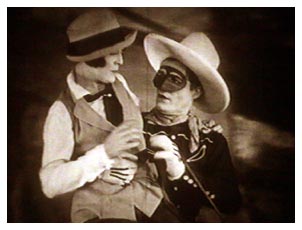 Tom Mix was reputed to have performed
all of his own stunts, however, Smith notes, "In reality,
the cowboy actors sometimes used doubles, but studios swore to
secrecy anyone standing in for a western star. Even when western-film
director Lambert Hillyer broke the code of silence surrounding
this issue and admitted that Tom Mix and William S. Hart didn't
always perform their own stunts, fans were disinclined to believe
him, as such information damaged the sense of 'authentic' heroic
manhood on which the actors had built their careers." It
would make sense that long shots such as those mentioned above,
when there is no way to tell if it's the star or not, would be
made with a stand-in. After all, Mix was 46 years old when "The
Great K&A Train Robbery" was made, but, alas, we'll probably
never know if it was really Mix dangling from that rope below
the cliff or not.
Tom Mix was reputed to have performed
all of his own stunts, however, Smith notes, "In reality,
the cowboy actors sometimes used doubles, but studios swore to
secrecy anyone standing in for a western star. Even when western-film
director Lambert Hillyer broke the code of silence surrounding
this issue and admitted that Tom Mix and William S. Hart didn't
always perform their own stunts, fans were disinclined to believe
him, as such information damaged the sense of 'authentic' heroic
manhood on which the actors had built their careers." It
would make sense that long shots such as those mentioned above,
when there is no way to tell if it's the star or not, would be
made with a stand-in. After all, Mix was 46 years old when "The
Great K&A Train Robbery" was made, but, alas, we'll probably
never know if it was really Mix dangling from that rope below
the cliff or not.
Of course, every western film has to have a chase - usually as the film's climax, but Tom Mix inserts a very exciting chase in the first few minutes of the film. To add to the excitement, Mix's chase has a little twist to it.
The bandits notice the railroad president's (Cullen) daughter (Madge) riding by herself in her carriage along a road down in the gorge. They get the idea to kidnap her for ransom. Tom overhears, but before he can get down from his high perch, the bandits discover him and start shooting. Tom slides quickly down the rope, all the while shooting back at the bandits, right onto Tony's saddle. Off he goes to rescue the girl before the bandits can get to her. Unfortunately, because Tom is undercover, he is wearing a mask, á la the Lone Ranger, and when the girl turns and sees him coming after her, she tries to get away. Tom's catches up with her and tries to get her to transfer over to his horse from the speeding carriage, but she fights him. He finally succeeds, but continues to contend with a squirming saddlemate who won't stop beating on him. All the while, the bandits are not far behind.
To add even more to this scenario of mistaken identity, Cullen's train is on the other side of the river, and he and his crooked secretary, Holt, are watching the chase. Cullen doesn't realize it's his daughter and thinks a sheriff's posse is after a masked bandit who has kidnapped a girl. To make matters worse, Tom has to get the girl across the river and deposit her on the train - to a man who thinks he's a bandit. Now, do you get the idea why the first reel of this film is so exciting?
Of course, words on paper don't do the film justice. All
of this action, too, is enhanced by the location Mix chose for
his film. The wide river running through the mountain gorge with
a road on one side and a train track on the other is perfect.
The scenery is breath-taking, and the photography is beautiful.
Joe Franklin noted in Classics of the Silent Screen (Cadillac
Publishing Co., Inc., 1959), "Most of Mix's films were made
far away from the studios, on choice locations. He made a point
of using the scenic beauties of the National Parks in his movies
and had an especial fondness for the Grand Canyon. These picturesque
locations were flawlessly photographed by Dan Clark, Mix's favorite
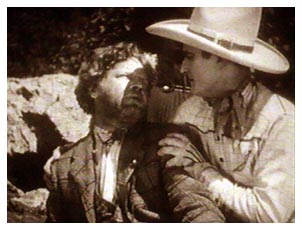 cameraman -- an adventurous individual with
a rugged pre-movie background similar to Mix's own. Sharp, well-framed
shots, fine panoramics and crystal clear focus were all a matter
of course for Clark. He was one of the best cameramen in the business,
and his contribution to the success of Tom's pictures was a major
one."
cameraman -- an adventurous individual with
a rugged pre-movie background similar to Mix's own. Sharp, well-framed
shots, fine panoramics and crystal clear focus were all a matter
of course for Clark. He was one of the best cameramen in the business,
and his contribution to the success of Tom's pictures was a major
one."
A surprisingly good addition to the film is Harry Grippe (sometimes listed as Harry Gripp) as the hobo Deluxe Harry. Tom rescues Harry after his hammock, which is tied underneath the president's train car, breaks loose while the train is rushing through the mountain gorge. It turns out that Harry served during the war with Tom, so Tom enlists his former army buddy to help track down the robbers. Looking very similar in appearance to Gibson Gowland in "Greed," Harry, with skimmer and ill-fitting plaid coat, snaps to attention and salutes his former captain. Grippe is used to add a humorous element to the story, but it's not overdone, and he proves to be very capable in helping Tom, not a bungler.
Grippe even has a very touching scene in the movie, too. After the bandits stop the train and steal the strong box, Tom gets it from them and hands it off to Harry while he keeps the bandits at bay atop the stopped train. Harry scurries down the track only to be shot in the leg by Cullen's crooked secretary, Holt. Harry continues to drag himself along the track, hugging the strong box and trying to get away from Holt, even though the crook has caught up with him. Cullen and Madge arrive, and Harry hugs Cullen's leg telling him Holt is an informant for the bandits. This forces Holt to reveal his double identity, holding Cullen at bay with a gun and getting away with the strong box. When the shooting is over and Tom returns to Harry, the pitiful hobo, still lying on the ground with an injured leg, won't look up at his friend -- he feels he has let him down. This kind of stuff is rare in a "B" western from this period and goes to show that Tom Mix knew how to make good movies -- and not based solely on stunt work. Grippe is not a well-known actor from the silent era, and, according to The AFI Catalog, only made a dozen movies between 1917 and 1930.
Dorothy Dwan plays the heroine, and, although she's not
one of the great beauties of the silent screen, she makes an attractive
and appealing love interest playing her part well. Dwan was no
stranger to action, either. She performed in many of the break-neck
paced Larry Semon comedies (to whom she was also married). She
wasn't just relegated to two-reel comedies, though. She was an
accomplished actress who was very busy during the silent era with
28 feature films to her credit between 1922 and 1930. Semon died
in 1928, and Dwan retired from films when she remarried in 1930.
This and another marriage failed. She worked for a time as a nurse
in Kansas City, Mo., and then as a realtor 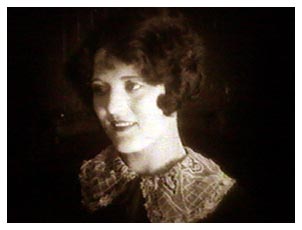 in
California. She died in 1981.
in
California. She died in 1981.
In A History of the American Film Industry from Its Beginnings to 1931 (Dover Publications, Inc., 1930) Benjamin Hampton said Mix's best films were grossing between $600,000 and $800,000 each. According to Richard Koszarski in An Evening's Entertainment (University of California Press, 1990), ". . . since he was releasing seven or eight of them a year, his annual earnings must have compared quite favorably with those of even the most prominent dramatic or comedy stars." Hampton goes on to say that Mix made more money for Fox studios than any other star. His weekly salary, at its height, was reported to be $17,000.
Obviously, no other western star could touch this level of popularity. Hart's somber, good-bad man films went out of vogue after the war, and Mix, with his fantasized version of a western hero, was just what the jazz-aged twenties wanted. It is interesting that Mix created the mold for the western stars that were to come in the 1930's and 1940's. Hart's western were adult westerns. Mix's pulled in the kids, and with the honorable, clean-living image he projected both on and off the screen, that was just what the doctor ordered for the young boys -- an image that continued with Autry, Rogers, Elliott, and the other western talkie stars. Koszarski said, "Such behavior laid the foundation for the B-Western genre, a category identified not merely by budgetary limitations, but by an entire Mix-inspired 'code of the West.' B-Western heroes inhabited a world without ambiguities, avoided romantic entanglements, lived clean American lives, and would rather rope a rustler than shoot him full of holes."
"While the films could be and were enjoyed by adults -- they were, after all, western parallels to the Fairbanks frolics -- they were designed primarily for the youngsters," said William K. Everson (American Silent Film, Oxford University Press, 1978).
Because that "Fairbanks style" is so evident in "The Great K&A Train Robbery," it most certainly will appeal to anyone who is a Fairbanks fan, as well. This is one that doesn't require the viewer to be a "dyed in the wool" western addict. It's an engrossing story with plenty of action, good acting and a well-done love interest to supplement the train robber yarn. Although Koszarski mentions that "love entanglements" were avoided by the B-Western stars, there is a solid subplot involving Tom's pursuit of the girl. The fact that she thinks he's a charming bandit and doesn't know he's an undercover agent, adds to the interest. As a matter of fact, we see her sitting in her room reading a book entitled Romantic Highwaymen of History and dreaming about Tom. However, she's torn between her attraction to him and the realization that falling in love with a bandit is simply unthinkable. As noted, there IS a love interest in this B-Western, and it's well-done and is woven into the story of the bandits/train robbery excellently.
"Tom Mix, always the great looking guy in a picture, has set a high mark for the 'western boys' in this one," the Variety reviewer said. "They will have to go a lot to approach it in action . . . ," and overall quality, as well. Whether you're a western fan or not, it's a good bet you'll enjoy this film.
The version reviewed is the Paul Killiam print which is one of several Killliam titles that were released through Critic's Choice Video at one time and have now been discontinued. The print quality is excellent so that we get to see the true beauty of the Colorado scenery. It's doubtful that even color could make the views and vistas any better. And, of course, with most Killiam prints, you'll get a superb William Perry piano score, and this one is no exception. The music is perfect in every way, always suitable to the mood of the scene and enhancing the viewing experience. Perry was certainly one of the "masters." The Variety review notes the film is 55 minutes. Whether this is an estimation or not is not known. The Killiam print runs 53 minutes, however, if two minutes are missing from the film, it is certainly not noticeable. And a added tidbit - many of the Killiam prints discard the opening title in favor of the Killiam opening title. This one has all of the original opening titles with background artwork - a nice added treat!
Copyright © 2005, by Tim Lussier. All rights reserved.